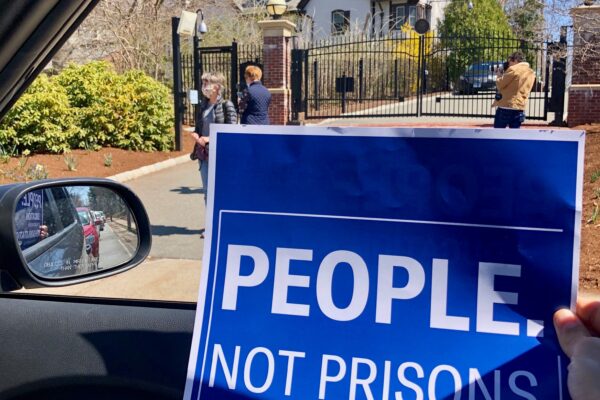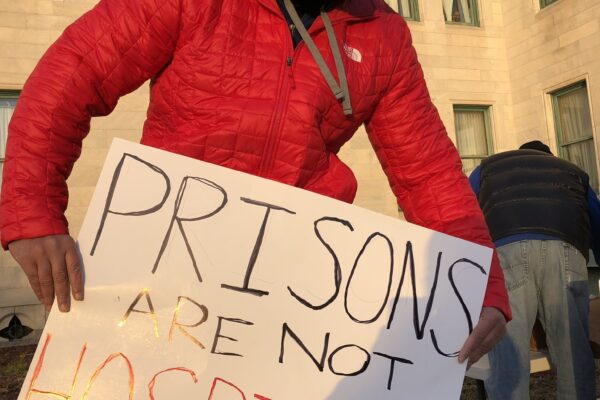As the COVID-19 crisis continues to grow exponentially, people who are incarcerated in Connecticut prisons are extremely vulnerable, but largely being ignored by the state. Public health experts have sounded the alarm about the need for Connecticut to decrease incarceration as part of the state’s COVID-19 response. Despite consistent calls from the ACLU of Connecticut and other organizations, starting as early as March 10, March 12, March 16, and March 19 (here and here), neither Governor Ned Lamont nor state agencies have made efforts to protect public health by issuing plans to thoughtfully, safely, and quickly release people. While the Department of Correction (DOC) and Governor have done a rhetorical about-face by now claiming they are releasing people, they still have not publicly produced a plan for releases, and they still will not say whether any people were actually released because of COVID-19 (as opposed to other bases).
So many people and agencies in this state have failed to act to protect incarcerated people. What makes this especially infuriating is that under state law more than 100 different state government agencies – including the Governor and DOC – could take steps right now to reduce the number of people who are sitting in prisons, where they are at risk during the pandemic. For example:
- Connecticut’s 92 municipal police departments and the state police have enormous control over inflow into state jails and prisons. Police could use their existing discretion to issue written complaints and summonses to people suspected of violating the law instead of arresting them. There hasn’t been a state directive to make that happen.
- The 13 State’s Attorneys and Chief State’s Attorney Richard Colangelo have the statutory authority to direct prosecutors to alter pretrial detention recommendations, make more thoughtful sentencing recommendations, and approve more requests to modify existing sentences, or at least not oppose hearings on sentience modifications. They haven’t done so.
- Courts could provide directives to judges about using pretrial detention, presentencing detention, sentencing alternatives, modifications of existing sentences, and early probation to reduce the number of people incarcerated. They haven’t.
- DOC could change its standards on releases to homes, furloughs, or early parole recommendations – all things that are within DOC’s existing powers that it has not exercised.
- The Board of Pardons and Paroles (BOPP) has independent statutory authority to grant paroles and commutations to many people who are incarcerated. But the BOPP hasn’t, with the head even saying in a press interview that it is conducting “business as usual” during the pandemic.
- The Governor has failed to take seriously his responsibility to protect the health and safety of incarcerated people. This responsibility exists all the time, but it especially critical – and explicit – during a public health emergency.
This utter failure of coordination and leadership has led to understandable confusion about what the state is doing and also about what incarcerated people and their loved ones can do to seek help.
The list of agencies that could act goes on.
- People held pretrial could have their conditions of release modified so that they could actually meet those conditions – including by modifying or eliminating money bail. Multiple agencies (the Court Support Services Division, the judge in the case, or the prosecutor for the case) could recommend changing conditions of release. In addition, people charged with misdemeanors and class D and E felonies could be released to their homes by DOC.
- People who have been convicted but not yet sentenced could be released to the community under the custody of the Court Support Services Division by the judge in that person’s case.
- People who are incarcerated for not paying a fine could be released by the DOC or, if the person applies, by the judge in that person’s case.
- People who are incarcerated for motor vehicle offenses under §§ 14-215, 14-227a(g), and 14-227m(c)(1) of the Connecticut General Statutes could be released to their residences by DOC.
- People who are incarcerated for certain drug offenses under §§ 21a-267 or 21a-279 of the Connecticut General Statutes could be released to their residences by DOC.
- People with 180 days or less remaining in their sentence could be paroled by BOPP. People who have been convicted of capital felonies, murder with special circumstances, felony murder, arson murder, murder, aggravated sexual assault, violations of §§ 53a-100aa or 53a-102 of the Connecticut General Statutes, or offenses that involve the use, attempted use, or threatened use of physical force against another must have completed at least 95% of their sentence to be eligible.
- People who have completed at least 50% of their sentences could be paroled by BOPP. People who have been convicted of capital felonies, murder with special circumstances, felony murder, arson murder, murder, aggravated sexual assault, violations of §§ 53a-100aa or 53a-102 of the Connecticut General Statutes, or offenses that involve the use, attempted use, or threatened use of physical force against another are not eligible for parole by BOPP under this statute.
- People who have completed at least 85% of their sentences could be paroled by BOPP. This applies to people who have been convicted of violation of §§ 53a-100aa or 53a-102 of the Connecticut General Statutes and of offenses that involve the use, attempted use, or threatened use of physical force against another. People convicted of capital felonies, murder with special circumstances, felony murder, arson murder, murder, and aggravated sexual assault are not eligible for parole by BOPP under this statute.
- People with sentences of two years or less can be evaluated for a community release plan by the Court Support Services Division.
- People with indeterminate sentences could be paroled by BOPP if they have served at least the minimum sentence. People who have been convicted of capital felonies, murder with special circumstances, felony murder, arson murder, murder, aggravated sexual assault, violations of §§ 53a-100aa or 53a-102 of the Connecticut General Statutes, or offenses that involve the use, attempted use, or threatened use of physical force against another are not eligible for parole by BOPP under this statute.
- People with sentences of three years or less could seek sentence modification from the judge in their case.
- People with sentences of three years or more could seek sentence modification from the judge in their case, but would first need to get approval to do so from the state’s attorney for the case.
- People serving sentences at Manson Youth Institution, Cheshire Correctional Institution, or York Correctional Institution could seek a recommendation for early parole by DOC.
- All incarcerated people could seek a furlough from the DOC, a commutation from BOPP, or a reprieve directly from the Governor under Article fourth, § 13 of the Connecticut Constitution.
Remembering that most incarcerated people will fall into more than one of these categories, it is clear that state actors in every branch and at every level are failing people imprisoned in Connecticut.
It is not too late for Connecticut’s elected officials and agency heads to reverse course. A first step would be an executive order from Governor Lamont laying out a detailed, thoughtful plan to protect public health by releasing incarcerated people, that considers community safety and gives direction to agencies. If Governor Lamont continues to ignore this problem, though, leaders across Connecticut already have the power to reduce incarceration on their own. They should do so to save lives.
People are not sentenced by the courts to suffer and die in a pandemic. By reducing incarceration to protect prison workers and incarcerated people, Connecticut can secure public health both inside and outside prisons.




